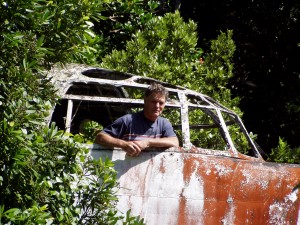New Zealand is lucky to have five DXCC entities which include mainland New Zealand (ZL1 to ZL4), Antarctica – ZL5, Raoul Island in the Kermadec chain of islands – ZL8 and Auckland/ Campbell Islands – ZL9. With the exception of the mainland these DXCC entities are extremely difficult to activate except for Chatham Island. Chatham is easy to get to and has no restrictions. Although not rare, the island is keenly sought after by the DX community. At the outset this was a “Kiwi” operation which grew out of a few interested DXers from the Kiwi DX Group.
Eventually the team grew to nine with Mike ZL2CC, Phil ZL2RVW, Wayne ZL2WG, Mark ZL3AB, John ZL1BYZ, John ZL1ALZ, Leonie ZL2LE and the two team leaders Morrie ZL2AAA and Lee ZL2AL. Accommodation is scarce on Chatham Island and we were not able to activate the planned DXpedition in 2008 so the decision was made to go in March 2009. Morrie, ZL2AAA arranged lodgings at the farm run by Ken Worthington known as the “Chathams Fishing Experience” located at Kaiangaroa on the North East tip of the island shown in the map of the island below.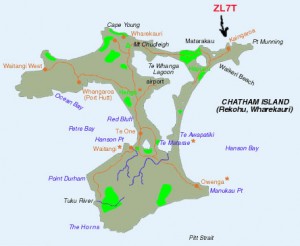
We originally planned to activate two stations. As the team grew in numbers we doubled the number to four stations. The Chatham Air Convair 580 only flies to Chatham from Napier on Thursday so it had to be a 7 day operation with two days for travel which left us with only five operating days. Flights to Chatham usually arrive from Christchurch or Wellington.
The Chatham Islands are a group of 10 islands about 800 kilometers east of from New Zealand. The island was a volcano many thousands of years ago and time has eroded the surrounds leaving a lagoon crater in the centre of the island. Even though the land is fairly flat, it does have a few conical hills and basalt rocky outcrops on the northern coast. Most of the land is fern or pasture covered; although there are some areas of forest and plenty of shrubs and bushes throughout the island. The most famous species of the islands are the Magenta Petrel and the Black Robin, both of which came perilously close to extinction before being saved through conservation efforts.
Chatham History
Chatham Island’s main industry is fishing and the shellfish is harvested in the inshore waters of the Chatham Island and exported fresh and frozen to many countries. Over the past decade a developing tourism industry is helping Chatham Islanders to continue living there. Accommodation is less primitive and tourism is becoming a major source of income for the residents. The main settlements are at Waitangi, Kaingaroa, Te One, Port Hutt and Owenga. 40% of Islanders are of Moriori decent or Maori decent. The Moriori were the first settlers on the Chathams around 1500 AD who named it Rekohu. The Maori name of the Island is Wharekauri. Chatham and Pitt are the only inhabited islands, with the remaining smaller islands being conservation reserves. They are the first inhabited islands in the world to see the dawn of the new day. The international dateline lies to the east of the Chathams which are 45 minutes ahead of New Zealand time. The last few weeks before departure became increasingly hectic with the checking and testing all the gear plus arranging publicity and keeping in touch with the team members by email as most of the equipment was sourced from the team members. Morrie ZL2AAA and I were in touch daily for months testing and packing the equipment.
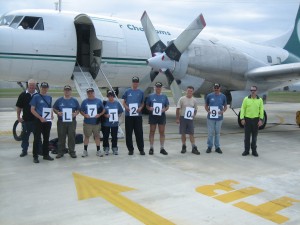 The team met at the Napier airport a few days later on March 5 and boarded for the short flight to Chatham. (Photo left) The flight was easy and the weather fine. An hour and half later saw us loading the same gear onto a truck at the Chatham airport ready for the drive to the farm and fishing camp. The trip is pleasant with the Chatham tundra-like scenery to look at. We followed the truck with all the equipment and the ensuing 100M trailing cloud of dust on the gravely road up the middle of the island past the ancient lagoon to the farm near Kaiangaroa where we were confronted by several hectares strewn with old and new farm equipment of all types.
The team met at the Napier airport a few days later on March 5 and boarded for the short flight to Chatham. (Photo left) The flight was easy and the weather fine. An hour and half later saw us loading the same gear onto a truck at the Chatham airport ready for the drive to the farm and fishing camp. The trip is pleasant with the Chatham tundra-like scenery to look at. We followed the truck with all the equipment and the ensuing 100M trailing cloud of dust on the gravely road up the middle of the island past the ancient lagoon to the farm near Kaiangaroa where we were confronted by several hectares strewn with old and new farm equipment of all types.
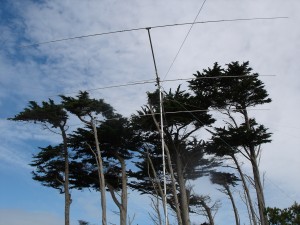 The next day it became immediately obvious that the very tall surrounding pine trees would double as excellent LF wire antenna supports. (Photo right) Several diesel generators power all the buildings and the house. A quick walk around the farm and we made the decision to use the farm implement shed as the main operating shack and another old storage shed as the 160M shack. The equipment was unpacked from the plastic fish boxes, operating tables set in place and everything was made ready to connect the antennas the next morning. In addition to the high wire loops we had to assemble and erect the Hi-Gain TH3 tri-band yagi and the 17M monobander by noon the next day. The TH3 tribander was mounted on a pile driver device which was a part of the tractor parked outside the shack. We did consider HF mobile but decided against it.
The next day it became immediately obvious that the very tall surrounding pine trees would double as excellent LF wire antenna supports. (Photo right) Several diesel generators power all the buildings and the house. A quick walk around the farm and we made the decision to use the farm implement shed as the main operating shack and another old storage shed as the 160M shack. The equipment was unpacked from the plastic fish boxes, operating tables set in place and everything was made ready to connect the antennas the next morning. In addition to the high wire loops we had to assemble and erect the Hi-Gain TH3 tri-band yagi and the 17M monobander by noon the next day. The TH3 tribander was mounted on a pile driver device which was a part of the tractor parked outside the shack. We did consider HF mobile but decided against it.
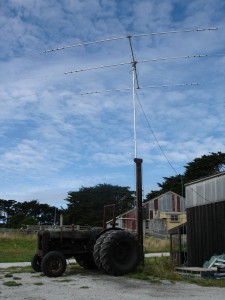 The tractor made a great support for the mast. (Photo below) By 10AM the next day one station was working and we decided to put ZL7T on 17M immediately and follow with more stations as the yagi antennas were put in place. By 10AM the next day one station was working and we decided to put ZL7T on 17M immediately and follow with more stations as the yagi antennas were put in place. The afternoon was devoted to installing the 80M and 40M loops plus the 30M vertical and finally the inverted “L” for 160M.
The tractor made a great support for the mast. (Photo below) By 10AM the next day one station was working and we decided to put ZL7T on 17M immediately and follow with more stations as the yagi antennas were put in place. By 10AM the next day one station was working and we decided to put ZL7T on 17M immediately and follow with more stations as the yagi antennas were put in place. The afternoon was devoted to installing the 80M and 40M loops plus the 30M vertical and finally the inverted “L” for 160M.
Although the trees were around 30M high we had no problem shooting a line over them with our air operated “Spud Gun.” Chris, ZL2DX constructed and loaned the gun to us and it proved invaluable. Within a half an hour we had rope lines over the tops of the trees ready to pull up the wire loops and by evening all three stations were on the air and followed by the 160M station later in the day.
On the Air
From the moment we hit the air the pileups started in earnest. Even though ZL7 is not in the top 100 most wanted there are thousands who need it for a new one or a band filler. Business was brisk to say the least. A few opening QSOs on any band and then the DX clusters unleashed the snarling pileups. It became apparent that 17M was going to be a very worthwhile band. As we progressed into the Friday evening, the big 40M and 80M loops started paying dividends. The noise level was generally very low and 80M sounded like 40M and 20M at times with so many EUs calling us. As with most Dxpeditions, CW is a far more effective mode to work pileups and our CW to SSB ratio showed it how effective CW was.
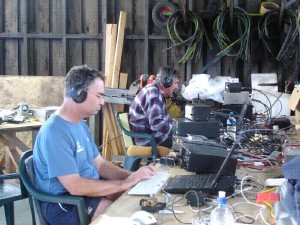 ZL1BYZ and ZL1ALZ worked long shifts during the five day operation to give many hams around the world a new one on CW. (Photo left shows JohnZL1BYZ and Mike ZL2CC operating from the farm shed radio shack) From the beginning the SFI of 69 plagued us with poor propagation. We were able to catch a few band openings on 15M while 12M and 10M propagation was non-existent in our part of the world. At times 20M was quite dead with no signals being heard from anywhere.
ZL1BYZ and ZL1ALZ worked long shifts during the five day operation to give many hams around the world a new one on CW. (Photo left shows JohnZL1BYZ and Mike ZL2CC operating from the farm shed radio shack) From the beginning the SFI of 69 plagued us with poor propagation. We were able to catch a few band openings on 15M while 12M and 10M propagation was non-existent in our part of the world. At times 20M was quite dead with no signals being heard from anywhere.
The ARRL DX Contest was scheduled for Saturday. We were aware of the test before we left and felt that it would help our totals. In fact the heavy demand for space in the 40M and 80M phone DX windows meant that our signals from the bottom of the planet were swamped by the rest of the world. Meanwhile 17M, 30M continued to provide some impressive long runs.
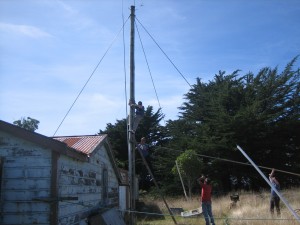 Our makeshift inverted “L” on 160M provided a few EU and USA contacts on Saturday night and good signals around the Pacific. Sunday night was better and our window openings to JA, EU and the USA became quite exciting. On Monday night 60M came alive and our inverted L worked very well. 160M was never intended as a major activity but once the team experienced the fun of working other countries on top band they were into it, making adjustments, and changing hardware to reduce noise and interference. Their efforts were rewarded on Monday night when we worked into the USA and Europe along with a wall of JAs calling us. The pileups soon disappeared because the grey line and sunrise doesn’t hang around waiting for us hams. We were astounded at the signal strengths of AA0RS and N8GZ when the opening occurred. It was interesting to listen to the grey line propagation hit the West coast USA and roll across the continent to the East coast with 10 minute windows.
Our makeshift inverted “L” on 160M provided a few EU and USA contacts on Saturday night and good signals around the Pacific. Sunday night was better and our window openings to JA, EU and the USA became quite exciting. On Monday night 60M came alive and our inverted L worked very well. 160M was never intended as a major activity but once the team experienced the fun of working other countries on top band they were into it, making adjustments, and changing hardware to reduce noise and interference. Their efforts were rewarded on Monday night when we worked into the USA and Europe along with a wall of JAs calling us. The pileups soon disappeared because the grey line and sunrise doesn’t hang around waiting for us hams. We were astounded at the signal strengths of AA0RS and N8GZ when the opening occurred. It was interesting to listen to the grey line propagation hit the West coast USA and roll across the continent to the East coast with 10 minute windows.
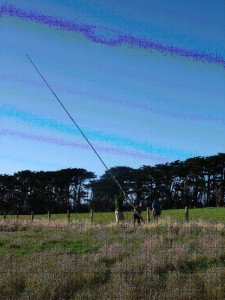 My experience 10 years ago with 30M on ZL9 showed that a simple resonant quarter wave vertical with above ground radials would produce good results. That proved correct with our homebrew vertical working extremely well (Photo right) Mark ZL3AB wanted to work CW and RTTY on that band and with the IC7000 and Writelog combination and no amplifier we were working everywhere in the world. The pileups just went on and on to Mark’s delight. 17M opened nicely most mornings an hour or so after sunrise. 17M and 30M have become a feature of DXpeditions since the WARC bands have been introduced. Our decision to take a Morrie’s homebrew 3el 17M yagi paid off because 17M was our most useful and productive band. The pileups were always there.
My experience 10 years ago with 30M on ZL9 showed that a simple resonant quarter wave vertical with above ground radials would produce good results. That proved correct with our homebrew vertical working extremely well (Photo right) Mark ZL3AB wanted to work CW and RTTY on that band and with the IC7000 and Writelog combination and no amplifier we were working everywhere in the world. The pileups just went on and on to Mark’s delight. 17M opened nicely most mornings an hour or so after sunrise. 17M and 30M have become a feature of DXpeditions since the WARC bands have been introduced. Our decision to take a Morrie’s homebrew 3el 17M yagi paid off because 17M was our most useful and productive band. The pileups were always there.
The weather was generally good and the team settled into a routine of operating, sleeping and eating. Near the end of our time there it rained at night and the weather turned a bit colder. Occasionally we had to secure the antennas and gear a cold front and winds from the south came though. The main operating shack was located inside an open shed housing farm implements and trucks. We placed a large tarpaulin over the opening but that didn’t seem to keep the cold out in the middle of the night.
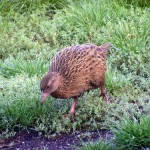 Chatham Island is the home of native birds such as the Weka and the Black Robin. A Weka is about the size of chicken and is a motley light brown in colour. It cannot fly. They are edible, if not a little on the tough side and there must be thousands of them roaming wild everywhere on Chatham. If a door was left open you would soon be chasing a weka out of the house. Our radio shack seemed to be a target and they roamed freely around our legs at times while we were operating. Occasionally two wekas would turn on each other and let out a shrill high powered screech which was quite alarming in the middle of the night.
Chatham Island is the home of native birds such as the Weka and the Black Robin. A Weka is about the size of chicken and is a motley light brown in colour. It cannot fly. They are edible, if not a little on the tough side and there must be thousands of them roaming wild everywhere on Chatham. If a door was left open you would soon be chasing a weka out of the house. Our radio shack seemed to be a target and they roamed freely around our legs at times while we were operating. Occasionally two wekas would turn on each other and let out a shrill high powered screech which was quite alarming in the middle of the night.
Sunderland Flying Boat Wreck
Almost 50 years ago the RNZAF operated a fleet of 16 Short S-25 Sunderland flying boats for long range maritime reconnaissance, ASW and SAR duties around the Pacific. This particular aircraft (NZ-4111) truck a reef in the bay near Kaiangaroa while taking off in November1959. The aircraft was cut into sections and hauled ashore to the farm where we operated ZL7T from. Most of the wreck still remains under the trees a short walk away where it was left all those years ago. The size of this giant four engine aircraft was impressive when you stood on the ground looking up over to 6M to the main cockpit section window. The wreck has been cannibalized over the years for spare parts and anything useable on the farm. The main wing spar was used in the construction of one of the farm buildings. Most of the aluminium sections are corroded and covered in lichen and moss but a sense of history and a bygone age still prevails.
We seemed to have a pipeline into the JAs and USA and the EUs found it very hard to break through the walls at times. During the initial planning we wanted to give the VKs and ZLs the experience of working a new country. To that end we took short windows out from running pileups and called for VKs and ZLs to work us. The plan was amazingly successful as so many of them took their hand keys out of the cupboard and made the effort. On the other hand the joy of some east coast USA stations after working us on 160M was pretty hard to beat. At times the 160M and 80M bands sounded like 20M with the pileups that resulted. The 30M shack was located in the corner of an abandoned wool shed about 50M away from the main shack and there was a pen full of young pigs half way in between. As we walked between the sheds the pigs were ever hopeful of being fed and created a squealing din as we walked by. The pigs became especially anxious as we manually turned the 17M yagi about 15M from their pen.
The eating was memorable as our host Ken is a very capable cook with an abundance of sea food on his doorstep. Several of us were invited out for a short fishing trip. One fishing trip of around 3 hours produced 10 blue cod and 10 Trevalli (Photo left) while another short trip harvesting Paua, also known as black abalone from around the rocks gave us some wonderful fresh seafood dinners. A short walk away into one of the nearby fields produced baskets full of fresh mushrooms to accompany the seafood. Fine dining indeed!
Tear Down
The weather was generally quite good during our stay with temperatures ranging from 6C to 15C but the overcast windy days often dominated the sunshine. Chatham Island at 44 degrees south of the equator is well known for its strong prevailing westerly winds shaping the tall one sided pine trees. Huge trees which began growing vertical from the trunk base ended up with the tops being 90 degrees over horizontal years later. The good news is that the bent over top branches make great supports for antennas! As we had to be at the airport loaded and ready to go early
Thursday morning and the plan was to QRT Wednesday afternoon. The weather looked ominous and ready to change and a change of plan resulted in getting all the antennas down and the gear packed by noon before the weather turned nasty. We decided to leave the 6mm nylon ropes up over the high trees in the hopes that some DXpedition in the future will be able to use them to haul up high antennas easily.
The last night of most Dxpeditions to Chatham usually results in a debriefing and wind down dinner at the local eatery in Waitangi about an hour away. An enjoyable time was had by all the team. We would have liked to have stayed a few days longer but the aircraft schedule doesn’t permit it unless we stayed a second full week. Our objective was to concentrate on the lower bands and the WARC bands and have fun while doing it. Only one of the team had ever been on a DXpedition previously. It was a revelation to many team members that instead of being the hunter while working DX we were the hunted. It was a new experience for many of them to have to adopt strategies to cope with unruly pileups.
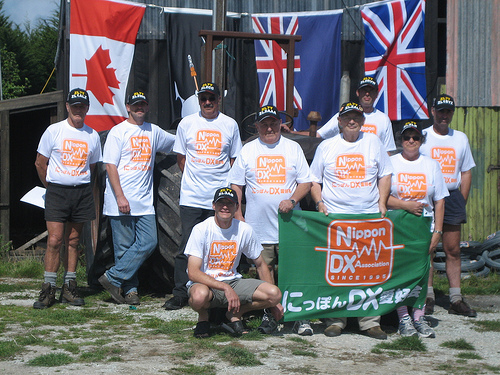
From Left to right: John ZL1ALZ, Wayne ZL2WG, Mike ZL2CC, Morrie ZL2AAA, Lee ZL2AL, Phil ZL2RVW, Leonie ZL2LE, John ZL1BYZ and Mark ZL3AB kneeling at the front.

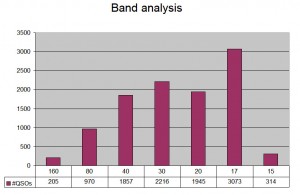 The team members were very experienced DXers and rose to the challenge. The statistics of our operation are on the ZL7T website – www.zl7t.com CW dominated our operation while 17M and 30M were the most productive bands. We made 10,580 QSOs during the 5 days and made a lot of low band enthusiasts very happy. The abysmal SFI was not kind to us with many times of the day just noise and few signals.
The team members were very experienced DXers and rose to the challenge. The statistics of our operation are on the ZL7T website – www.zl7t.com CW dominated our operation while 17M and 30M were the most productive bands. We made 10,580 QSOs during the 5 days and made a lot of low band enthusiasts very happy. The abysmal SFI was not kind to us with many times of the day just noise and few signals.
We would like to express our sincere gratitude to those people and organizations that helped us with generous donations and logistics support. Our sponsors GDXF – The German DX Foundation, NDXA – Nippon DX Association, CDXC – Chiltern DX Club, Noticebored – A Napier based internet security company, Icom New Zealand and the Kiwi DX Group – An informal group of ZL hams.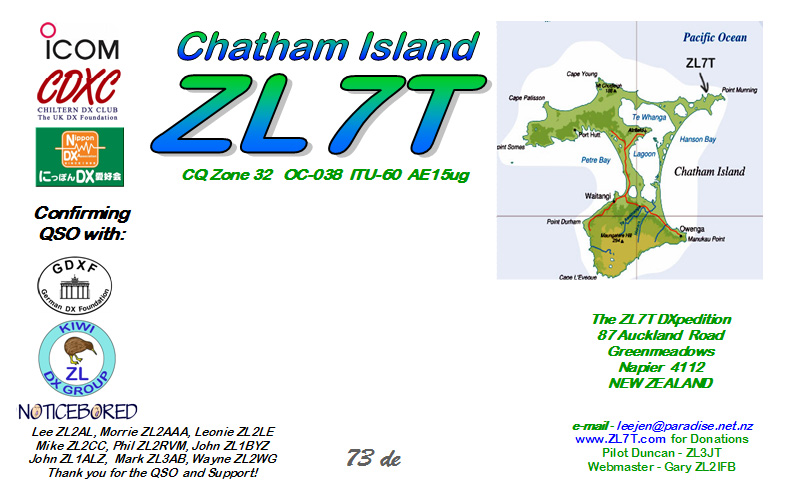
Thanks to our Pilot Duncan – ZL3JT for keeping us informed daily. Thanks to Gary – ZL2IFB, our Webmaster who designed the ZL7T website and kept it up to date with online log search facilities. Quite a few team members have expressed an interest in returning next year. The door is open.
73, Lee ZL2AL and the ZL7T Team

